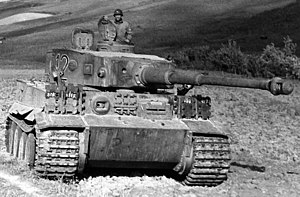
A captured Tiger I tank fitted with the 8.8 cm KwK 36
The 8.8 cm KwK 36 L/56 (German language: 8,8 cm Kampfwagenkanone 36 L/56) was an 8.8 cm electrically fired tank gun used by the German Wehrmacht, during World War II. This was the primary weapon of the PzKpfw VI Tiger I tank. It was developed and built by Krupp.
Design[]
It is often said that this gun was based on the FlaK 36 88 mm gun anti-aircraft gun. There are similarities between these weapons but they must be considered merely parallel designs. The KwK 36 could fire the same ammunition as the FlaK 18 or 36. The only difference were the primers that were of percussion type in the FlaK guns and electric in KwK 36. Also the ballistics were identical and both guns had a 56 caliber barrel. The KwK 36 was built to practically the same design as the 7.5 cm and 5.0 cm guns already used in German tanks, but with the structure scaled up considerably. The breech ring was square in section and 320 millimetres (13 in) on a side. The breech block was of vertical falling wedge type and operated semi-automatically, meaning that after firing the empty cartridge case was automatically ejected, while the breech cocked itself and remained open, ready to take the next round in.
L56 refers to the barrel length; the inside diameter of a gun barrel is one "caliber". In this gun, L56 means the barrel was 56 calibers long, or 56 times 88 mm = 4,928 mm, or almost 5 metres (16 ft). A longer gun barrel allows the expanding gas from the shell's charge to act on the projectile longer than a short barrel, giving it more velocity. For the Tiger II's 88 mm/L71, 71 times 88 mm is 6248 mm, over 6 metres (20 ft) long. This gun was amongst the most effective and feared tank guns of its time. It was also extremely accurate and had a very flat trajectory which meant the gun could usually still hit the target at some point even if the range to the target was incorrectly estimated. In British firing trials during the war, a British gunner scored five successive hits from 1,200 yards (1,100 m) at a 16 by 18 inches (41 by 46 cm) target.
Ammunition[]
Pzgr. 39 (APCBC)[]

An armour-piercing, capped, ballistic cap (APCBC) projectile with explosive filler and tracer.
- Weight of projectile: 10.2 kg (22.48 lbs)
- Muzzle velocity: 800 m/s (2,624 ft/s)
- Explosive filler 0.059 kg
Penetration figures given for an armoured plate 30 degrees from vertical
| Hit probability versus 2.5 x 2 m target [1] | |||
|---|---|---|---|
| Range | Penetration | in training | in combat |
| 100 m | 120 mm | 100% | 100% |
| 500 m | 110 mm | 100% | 100% |
| 1000 m | 99 mm | 100% | 93% |
| 1500 m | 91 mm | 98% | 74% |
| 2000 m | 83 mm | 87% | 50% |
| 2500 m | n/a | 71% | 31% |
| 3000 m | n/a | 53% | 19% |
Pzgr. 40 (APCR)[]
An armour-piercing, composite rigid (APCR) projectile had a sub-calibre tungsten core.
- Weight of projectile: 7.3 kg (16 lbs)
- Muzzle velocity: 930 m/s (3,051 ft/s)
Penetration figures given for an armoured plate 30 degrees from vertical
| Hit probability versus 2.5 x 2 m target [1] | |||
|---|---|---|---|
| Range | Penetration | in training | in combat |
| 100 m | 171 mm | 100% | 100% |
| 500 m | 156 mm | 100% | 100% |
| 1000 m | 138 mm | 100% | 93% |
| 1500 m | 123 mm | 97% | 74% |
| 2000 m | 110 mm | 89% | 47% |
| 2500 m | n/a | 78% | 34% |
| 3000 m | n/a | 66% | 25% |
Gr. 39 HL (HEAT)[]
A high explosive anti-tank (HEAT) round with a shaped charge.
- Weight of projectile: 7.65 kg (16.8 lbs)
- Muzzle velocity: 600 m/s (1,968 ft/s)
Penetration figures given for an armoured plate 30 degrees from vertical
| Hit probability versus 2.5 x 2m target [1] | |||
|---|---|---|---|
| Range | Penetration | in training | in combat |
| 100 m | 90 mm | 100% | 100% |
| 500 m | 90 mm | 100% | 98% |
| 1000 m | 90 mm | 94% | 62% |
| 1500 m | 90 mm | 72% | 34% |
| 2000 m | 90 mm | 52% | 20% |
| 2500 m | 90 mm | n/a | n/a |
| 3000 m | 90 mm | n/a | n/a |
See also[]
References[]
- ↑ 1.0 1.1 1.2 "Tiger I". Archived from the original on 2009-10-23. http://www.webcitation.org/5kjLZSinR.
- JENTZ, Thomas L.; Germany's TIGER Tanks - Tiger I and II: Combat Tactics; ISBN 0-7643-0225-6
External links[]
| Wikimedia Commons has media related to 8.8 cm KwK 36. |
- Information about the Tiger I and its KwK 36 gun at the Tiger I Information Center
- Historic and technical data on the 88 mm FlaK 36 and KwK 36, as well as on the PzKpfw VI Tiger I at the Armorsite
| ||||||||||||||||||||||||||||||||
The original article can be found at 8.8 cm KwK 36 and the edit history here.